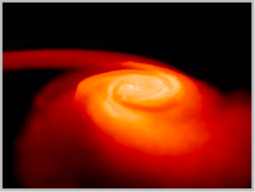Radio flares from compact binary mergers
Gravitational-wave (GW) detectors (e.g., advanced LIGO and Virgo) are being constructed now with the goal of detecting gravitational waves from binary neutron-star and/or black hole-neutron star coalescence out to distances of ~300-1000 Mpc. The detection of an accompanying electromagnetic signal would complement these efforts, providing an independent confirmation of the discovery and increasing the detectors’ effective sensitivity. Even before the completion of the advanced GW detectors, detection of light from any merger type (binary neutron stars or black hole/neutron star) would determine the merger rate, which is a parameter of utmost importance for the design and operation of the advanced GW detectors.
Recently, we have shown that the interaction of the outflow generated during the merger with the circum-merger medium would give rise to a radio flare. Under reasonable conditions, such flares will last between a month and several years and it can be bright enough for detection out to the detection horizon of advanced GW detectors. We are now working on improving the estimates of the radio flares properties and on an active search for radio transients that fit these properties.


Simulation of NS-NS merger
(Stephan Rosswog)




